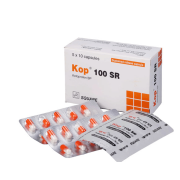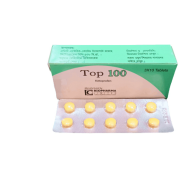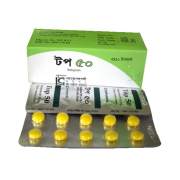Tramp CR Capsule (Controlled Release)
Ketoprofen
100 mg
Bristol Pharmaceuticals Ltd.
Unit Price: ৳ 10.11 (5 x 10: ৳ 505.50)
Strip Price: ৳ 101.10
Indications
The indications of Tramp CR are based on its anti-inflammatory, analgesic and antipyretic properties. Tramp CR is indicated for symptomatic treatment of:
- Rheumatoid arthritis
- Degenerative joint diseases
- Musculoskeletal and joint disorders such as tendinitis, sprain
- Pain, regardless of the origin, such as dental pain, headache and primary dysmenorrhea.
Pharmacology
Ketoprofen is a non-steroidal anti-inflammatory drug (NSAID) with analgesic and antipyretic actions. In addition to the inhibition of prostaglandin synthesis, it stabilizes lysosomal membranes in vitro and in vivo, inhibits leukotriene synthesis in vitro at high concentrations, and also exhibits antibradykinin activity in vivo. Ketoprofen produces analgesia by inhibiting the synthesis of prostaglandins peripherally and centrally. It has also been suggested that Ketoprofen causes the suppression of prostaglandin synthesis in the CNS (probably in the hypothalamus) leading to its antipyretic effect.
Ketoprofen is rapidly and almost completely absorbed from the GI tract. It is approximately 99% bound to plasma protein, mainly albumin. Following single or multiple oral doses in healthy adults, the elimination half-life of the drug has averaged 1.1-4 hours. It is rapidly and extensively metabolized in the liver, principally via conjugation with glucoronic acid. Following a single oral dose of Ketoprofen in healthy adults, about 50-90% of the drug is excreted in urine and about 1-8% in faeces within 1-5 days ; most urinary excretion occurs within 12-24 hours and most faecal excretion occurs within 24-48 hours. In case of IM injection, peak concentration of approximately 10 mg/L is reached at about 0.5-0.75 hour after a 100 mg dose. The elimination half-life is approximately 1.88 hour.
Dosage
Anti-inflammatory dosage: The recommended starting dose is 150 to 300 mg/day in 3 divided doses. Once the maintenance dosage has been established (usually 100 to 200 mg/day), the patient may be tried on a twice daily dose regimen. Alternatively, switching to the once daily form at the same dosage may be considered. The recommended maximum daily dose is 300 mg.
Management of pain and primary dysmenorrhea: The usual recommended dose is 25 to 50 mg, every 6 to 8 hours as necessary. The total daily dose should not exceed 300 mg.
Administration
The oral forms should be taken with fluids, preferably with food.
* রেজিস্টার্ড চিকিৎসকের পরামর্শ মোতাবেক ঔষধ সেবন করুন‘
Interaction
Not recommended drug associations Other NSAIDs (including cyclooxygenase-2 selective inhibitors) and high dose salicylates: Increased risk of gastrointestinal ulceration and bleeding. Anticoagulants Increased risk of bleeding.
- Heparin
- Vitamin K antagonists (such as warfarin)
- Platelet aggregation inhibitors (such as ticlopidine, clopidogrel)
- Thrombin inhibitors (such as dabigatran)
- Direct factor Xa inhibitors (such as apixaban, rivaroxaban, edoxaban)
If coadministration is unavoidable, patient should be closely monitored.
- Lithium: Risk of elevation of lithium plasma levels, sometimes reaching toxic levels due to decreased lithium renal excretion. Where necessary, plasma lithium levels should be closely monitored and the lithium dosage levels adjusted during and after NSAID therapy.
- Methotrexate at doses greater than 15mg/week: Increased risk of haematologic toxicity of methotrexate, particularly if administered at high doses (>15 mg/week), possibly related to displacement of protein-bound methotrexate and to its decreased renal clearance.
- Drug associations requiring precautions for use Medicinal products and therapeutic categories that can promote hyperkalemia (i.e. potassium salts, potassium-sparing diuretics, ACE inhibitors and angiotensin II antagonists, NSAIDs, heparins (low molecular-weight or unfractioned), cyclosporin, tacrolimus and trimethoprim): The risk of hyperkalemia can be enhanced when the drugs mentioned above are administered concomitantly.
- Corticosteroids: increased risk of gastrointestinal ulceration or bleeding.
- Diuretics: Patients and particularly dehydrated patients taking diuretics are at a greater risk of developing renal failure secondary to a decrease in renal blood flow caused by prostaglandin inhibition. Such patients should be rehydrated before initiating co-administration therapy and renal function monitored when the treatment is started.
- ACE inhibitors and Angiotensin II Antagonists: In patients with compromised renal function (e.g. dehydrated patients or elderly patients the co-administration of an ACE inhibitor or Angiotensin II antagonist and agents that inhibit cyclooxygenase may result in further deterioration of renal function, including possible acute renal failure.
- Nicorandil: In patients concomitantly receiving nicorandil and NSAIDs, there is an increased risk for severe complications such as gastrointestinal ulceration, perforation and hemorrhage.
- Cardiac glycosides: A pharmacokinetic interaction between Tramp CR and digoxin has not been demonstrated. However, caution is advised, in particular in patients with renal impairment, since NSAIDs may reduce renal function and decrease renal clearance of cardiac glycosides.
- Cyclosporin: Increased risk of nephrotoxicity.
- Tacrolimus: Increased risk of nephrotoxicity.
- Methotrexate at doses lower than 15mg/week: During the first weeks of combination treatment, full blood count should be monitored weekly. If there is any alteration of the renal function or if the patient is elderly, monitoring should be done more frequently.
- Pentoxifylline: There is an increased risk of bleeding. More frequent clinical monitoring and monitoring of bleeding time is required.
- Tenofovir: Concomitant administration of tenofovir disoproxil fumarate and NSAIDs may increase the risk of renal failure.
- Drug associations to be taken into account Antihypertensive agents (beta-blockers, angiotensin converting enzyme inhibitors, diuretics): Risk of decreased antihypertensive potency (inhibition of vasodilator prostaglandins by NSAIDs).
- Thrombolytics: Increased risk of bleeding. Probenecid: Concomitant administration of probenecid may markedly reduce the plasma clearance of Tramp CR.
- Selective serotonin reuptake inhibitors (SSRIs): increased risk of gastrointestinal bleeding.
Contraindications
Ketoprofen is contraindicated in patients who have a history of hypersensitivity reactions such as asthmatic attacks or other allergic-type reactions to ketoprofen, ASA or other NSAIDs. Severe, rarely fatal, anaphylactic reactions have been reported in such patients. Ketoprofen is also contraindicated in the following cases:
- Severe heart failure
- Active or history of peptic ulcer/hemorrhage
- History of gastrointestinal bleeding or perforation, related to previous NSAIDs therapy
- Severe hepatic insufficiency
- Severe renal insufficiency
- Third trimester of pregnancy
- Rectitis or history of proctorrhagia (rectal administration)
Side Effects
- Blood and lymphatic system disorders- Rare: haemorrhagic anaemia; Unknown: agranulocytosis, thrombocytopenia, bone marrow failure, hemolytic anemia, leucopenia
- Immune system disorders- Unknown: anaphylactic reactions (including shock) Psychiatric disorders; Unknown: depression, hallucinations, confusion, mood altered
- Nervous system disorders- Uncommon: headache, dizziness, somnolence, Rare: paraesthesia; Unknown: aseptic meningitis, convulsions, dysgeusia, vertigo
- Eye disorders- Rare: vision blurred
- Ear and labyrinth disorders- Rare: tinnitus
- Cardiac disorders- Unknown: exacerbation of heart failure, atrial fibrillation
- Vascular disorders- Unknown: hypertension, vasodilatation, vasculitis (including leukocytoclastic vasculitis)
- Respiratory, thoracic and mediastinal disorders- Rare: asthma; Unknown: bronchospasm (particularly in patients with known hypersensitivity to ASA and other NSAIDs)
- Gastrointestinal disorders- Common: dyspepsia, nausea, abdominal pain, vomiting; Uncommon: constipation, diarrhoea, flatulence, gastritis; Rare: stomatitis, peptic ulcer; Unknown: exacerbation of colitis and Crohn’s disease, gastrointestinal haemorrhage and perforation, pancreatitis
- Hepatobiliary disorders- Rare: hepatitis, transaminases increased
- Skin and subcutaneous disorders- Uncommon: rash, pruritis; Unknown: photosensitivity reaction, alopecia, urticaria, angioedema, bullous eruption including Stevens-Johnson syndrome, toxic epidermal necrolysis, acute generalized exanthematous pustulosis Renal and urinary disorders- Unknown: renal failure acute, tubulointerstitial nephritis, nephritic syndrome, renal function tests abnormal
- General disorders and administration site conditions- Uncommon: oedema Metabolism and nutritional disorders; Unknown: hyponatremia, hyperkalemia Investigations; Rare: weight increased.
Pregnancy & Lactation
During the first and second trimester: As the safety of ketoprofen in pregnant women has not been evaluated, the use of Ketoprofen during the first and second trimester of pregnancy should be avoided. During the third trimester of pregnancy: Prodenid is contraindicated during the last trimester of pregnancy. Ketoprofen is not recommended in nursing mothers.
Precautions & Warnings
Oral Forms: NSAIDs should be given with care to patients with a history of gastrointestinal disease (ulcerative colitis, Crohn’s disease) as their condition may be exacerbated. At the start of treatment, renal function must be carefully monitored in patients with heart failure, cirrhosis and nephrosis, in patients receiving diuretic therapy, in patients with chronic renal impairment, particularly if the patient is elderly. In these patients, administration of Tramp CR may induce a reduction in renal blood flow caused by prostaglandin inhibition and lead to renal decomposition.
Caution is required in patients with a history of hypertension and/or mild to moderate congestive heart failure as fluid retention and oedema have been reported in association with NSAID therapy.
Increased risk of atrial fibrillation has been reported in association with the use of NSAIDs.Hyperkalemia may occur, especially in patients with underlying diabetes, renal failure, and/or concomitant treatment with hyperkalemia promoting agents. Potassium levels must be monitored under these circumstances.
As with other NSAIDs, in the presence of an infectious disease, it should be noted that the antiinflammatory, analgesic and the antipyretic properties of Tramp CR may mask the usual signs of infection progression such as fever.
In patients with abnormal liver function tests or with a history of liver disease, transaminase levels should be evaluated periodically, particularly during long-term therapy. Rare cases of jaundice and hepatitis have been described with Tramp CR.
If visual disturbances such a blurred vision occur, treatment should be discontinued. The use of NSAIDs may impair female fertility and is not recommended in women attempting to conceive. In women who have difficulties conceiving or who are undergoing investigation of infertility, withdrawal of the NSAID should be considered.
Use in Special Populations
Elderly: It is advisable to reduce the initial dosage and maintain such patients on the minimal effective dose.
Hepatic impairment: These patients should be carefully monitored and kept at the minimal effective daily dosage.
Renal impairment: It is advisable to reduce the initial dosage and maintain such patients on the minimal effective dose.
Overdose Effects
Cases of overdose have been reported with doses up to 2.5 g of Tramp CR. In most instances, the symptoms observed have been benign and limited to lethargy, drowsiness, nausea, vomiting and epigastric pain. There are no specific antidotes to Tramp CR overdosages. In cases of suspected massive overdosages, a gastric lavage is recommended and symptomatic and supportive treatment should be instituted to compensate for dehydration, to monitor urinary excretion and to correct acidosis, if present. If renal failure is present, hemodialysis may be useful to remove circulating drug.
Therapeutic Class
Drugs for Osteoarthritis, Drugs used for Rheumatoid Arthritis, Non-steroidal Anti-inflammatory Drugs (NSAIDs)
Storage Conditions
Protect from light. Store below 30°C. Do not use later than the date of expiry. Keep all medicines out of the reach of children. To be dispensed only on the prescription of a registered physician.



